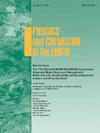利用地理探测器模型评估香港水质
IF 3
3区 地球科学
Q2 GEOSCIENCES, MULTIDISCIPLINARY
引用次数: 0
摘要
水质评价是水资源管理和环境科学的重要领域之一。在这种情况下,水的物理和化学参数,包括水温(WT)、pH、盐度(SAL)、溶解氧(DO),以及铁(Fe)、铝(Al)和钡(Ba)等微量元素的浓度,在评价水质中起着至关重要的作用。地理检测器模型(GDM)是一种强大的统计工具,可以通过检查方差和数据异质性来分析和预测这些参数对水质的影响。GDM的一个显著优点是它还可以有效地分析物理和化学参数之间的关系。在本研究中,我们使用GDM分析了影响水质指数(WQI)的7个物理参数和16个化学参数,同时考虑了它们在香港所有河流中的个体效应和相互作用。结果表明,悬浮固体(SS)对WQI的影响最大(0.45),而总磷(TP)对WQI的影响最大(0.85)。浊度(turr)和电导率(CON)在物理参数间的正相互作用最强(0.93),而Al和TP之间的正相互作用最强(0.92)。总的来说,研究表明化学参数比物理参数对WQI的影响更大。也就是说,WQI对化学参数的变化表现出更大的敏感性。本文章由计算机程序翻译,如有差异,请以英文原文为准。
Evaluating water quality using the Geographical Detector Model in Hong Kong
Assessing water quality is one of the most important fields in water resources management and environmental science. In this context, physical and chemical water parameters, including Water Temperature (WT), pH, Salinity (SAL), Dissolved Oxygen (DO), and concentrations of trace elements like iron (Fe), aluminum (Al), and barium (Ba) play a crucial role in evaluating water quality. The Geographical Detector Model (GDM) is a powerful statistical tool that can be used to analyze and predict the impact of these parameters on water quality by examining variance and data heterogeneity. A notable advantage of GDM is that it can also effectively analyze the relationship between physical and chemical parameters. In this study, we used GDM to analyze 7 physical and 16 chemical parameters that influence the Water Quality Index (WQI), considering both their individual effects and interactions in all rivers of Hong Kong. The findings showed that Suspended Solids (SS) had the greatest impact among physical parameters (0.45) on WQI, while Total Phosphorus (TP) was the most impactful chemical parameter (0.85). Additionally, the results revealed that Turbidity (TUR) and Conductivity (CON) showed the strongest positive interaction among physical parameters (0.93), while the highest interaction among chemical parameters was observed between Al and TP (0.92). Generally, the study suggested that chemical parameters had a greater influence on WQI compared to physical parameters. In other words, WQI showed greater susceptibility to chemical parameter variations.
求助全文
通过发布文献求助,成功后即可免费获取论文全文。
去求助
来源期刊

Physics and Chemistry of the Earth
地学-地球科学综合
CiteScore
5.40
自引率
2.70%
发文量
176
审稿时长
31.6 weeks
期刊介绍:
Physics and Chemistry of the Earth is an international interdisciplinary journal for the rapid publication of collections of refereed communications in separate thematic issues, either stemming from scientific meetings, or, especially compiled for the occasion. There is no restriction on the length of articles published in the journal. Physics and Chemistry of the Earth incorporates the separate Parts A, B and C which existed until the end of 2001.
Please note: the Editors are unable to consider submissions that are not invited or linked to a thematic issue. Please do not submit unsolicited papers.
The journal covers the following subject areas:
-Solid Earth and Geodesy:
(geology, geochemistry, tectonophysics, seismology, volcanology, palaeomagnetism and rock magnetism, electromagnetism and potential fields, marine and environmental geosciences as well as geodesy).
-Hydrology, Oceans and Atmosphere:
(hydrology and water resources research, engineering and management, oceanography and oceanic chemistry, shelf, sea, lake and river sciences, meteorology and atmospheric sciences incl. chemistry as well as climatology and glaciology).
-Solar-Terrestrial and Planetary Science:
(solar, heliospheric and solar-planetary sciences, geology, geophysics and atmospheric sciences of planets, satellites and small bodies as well as cosmochemistry and exobiology).
 求助内容:
求助内容: 应助结果提醒方式:
应助结果提醒方式:


